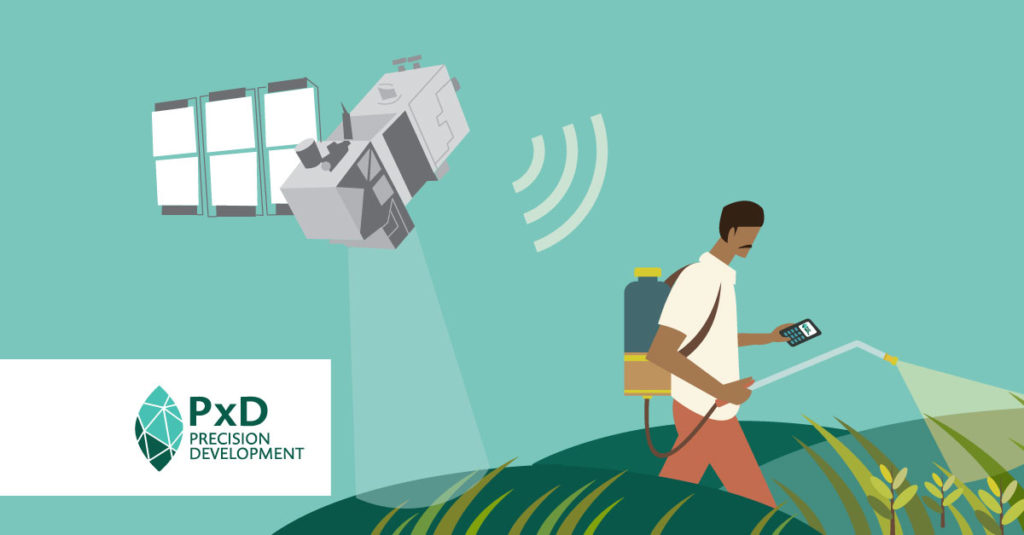Accurate weather forecasts would reduce uncertainty for farmers, yet they are under-supplied and under-studied in developing countries. Government and market failures reduce the quality and reach of weather information in rural regions, reducing its value for households. To address these gaps, Precision Development (PxD) is piloting the provision of improved forecasts to farmers in India and Pakistan. The pilot will investigate how farmers interpret and use weather information, including the cognitive and informational barriers that constrain adoption.

The costs of weather uncertainty
Smallholder farmers live with copious amounts of risk, leaving them vulnerable to income variability and losses. Weather uncertainty is a major source of this risk. A survey of farmers in poor, southern districts of India, for example, found that 73% of respondents had abandoned their crop at least once, in the ten years prior to being surveyed, after misjudging the onset of the monsoon; and one quarter had replanted (Giné et al., 2015). These activities are costly: the authors rank farmers by the accuracy of their monsoon predictions and show that the gross agricultural income of those in the 25th percentile is 8-9% lower than those in the 75th percentile. Other research documents how farmers respond to weather uncertainty by reducing investments in technologies or complementary inputs, which lowers their average profits (Zimmerman and Carter, 2003; Rosenzweig and Binswanger, 1993).
Because weather variability can be disastrous for poor households and is increasing with climate change, economists have dedicated much attention to products that mitigate its consequences, including index insurance and climate-resilient crop varieties. While effective in increasing farmers’ investments and profits, many of these innovations incur high distribution costs that limit their scalability (Cole & Xiong, 2017). PxD is therefore exploring an alternative solution for farmers that face increasing climate risk: accurate, phone-based weather forecasts.
Forecasts have a high potential for cost-effectiveness and scale. By reducing uncertainty over future conditions, they allow farmers to make better production decisions throughout the season. Long-range forecasts of conditions over one to three months can enable farmers to make more informed decisions about how much to invest or which crops to grow, while shorter-range products can be used to determine the best time to conduct activities like fertilizer application. These decisions have the potential to generate meaningful yield impacts; PxD’s agronomy team in India estimates that transplanting rice seedlings from the nursery to the field at the right time can generate yield increases of up to 10%, relative to transplanting too late. Moreover, the marginal cost of delivering phone-based forecasts is low relative to other products that reduce risk, meaning that the returns to their provision would increase with scale.
Currently, however, rigorous evidence on weather forecasts’ effects on farmer outcomes is sparse. Part of the reason may be the limited availability of accurate, useful forecasts in many developing countries. Producing high-quality weather predictions is costly and complex: state-of-the-art observation infrastructure, rapid data transmission systems, high-performance computing, and specialist staff are all required (Rogers et al., 2019). Cash-strapped public providers often lack this capacity, while the private sector has few incentives to serve poor consumers. As a result, the forecasts that smallholders can access are typically well behind the technology frontier.
The limited evidence base suggests that these quality shortfalls reduce forecasts’ value for farmers. For example, an observational study in India found that state-provided seasonal forecasts do increase agricultural profits, but only in the few areas where forecasts happen to be accurate (Rosenzweig and Udry, 2019). Additionally, in Ghana, preliminary results from an experimental evaluation of 48-hour, SMS-based forecasts, found effects on farmer behavior but not on profits (Fosu et al., 2018). Short lead times and a lack of complimentary advice may explain the lack of impact: a review of farmer-focused forecasts in developed countries finds that these factors reduce take-up and usefulness (Mase and Prokopy, 2014).
Unlocking the potential of weather forecasts
PxD’s new pilot aims to build the evidence on the benefits of improved forecasts for smallholders. We have partnered with the Climate Forecast Applications Network (CFAN), a private provider with expertise in developing innovative weather information tools in South Asia, to deliver hyper-local forecasts and related advisory to smallholders in India and Pakistan. CFAN’s products are anticipated to improve on existing forecasts in the region in terms of accuracy, lead times, and precision. Importantly, they can also be calibrated to predict weather phenomena that are particularly relevant for agricultural decision-making, such as prolonged dry spells suitable for fertilizer application or monsoon onset dates.
PxD’s pilot activities will test the efficacy of different intervention designs in both contexts, laying the groundwork for a large-scale randomized evaluation of weather forecasts’ effects on agricultural outcomes that we hope to implement in 2023. Some of the questions we will explore during this preliminary phase include:
- To what extent do farmers update their subjective weather expectations in response to different forecasts? What role do informational, cognitive, trust or other barriers play?
- How do farmers interpret probabilistic weather information? Do forecasts with a numeric probability of a weather event and a qualitative likelihood of the same event affect their beliefs differently?
- For which agricultural decisions could improved forecasts generate the greatest returns?
- Does improved weather information spread among farmers within and across villages?
The findings of the pilot and subsequent evaluation will have policy implications at PxD and beyond. For example, improved understanding of the returns to information products that reduce agricultural risk will inform PxD’s prioritization of new services, such as pest prediction models. The project will also seek to provide policymakers with evidence and incentives to increase funding to improve forecasts in regions that are under-served by governments and markets.
Many thanks to Sam Carter, Jonathan Faull and Yifan Powers for their excellent comments and suggestions on an earlier iteration of this post